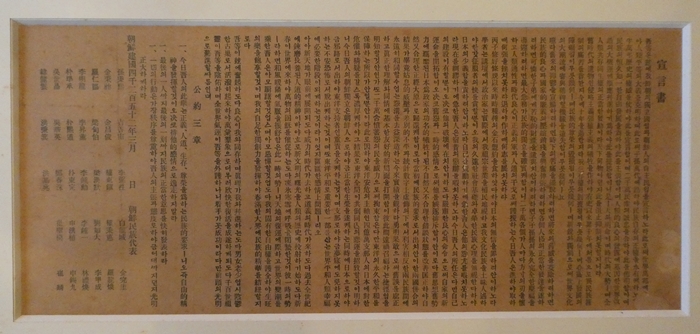
Masao Sato on May 29 recounts what led him to donate his family’s original copy of the Korean Declaration of Independence to the Independence Hall of Korea during his visit to Deoksugung Palace in Seoul.
By Kim Eun-young and Lee Jihae
Photo = Kim Eun-young
Seoul | June 7, 2019
A retired Japanese teacher of history has returned an original copy of Korea’s Declaration of Independence to the Independence Hall of Korea in Cheonan, Chungcheongnam-do Province, a document that his family had kept over three generations spanning 100 years.
Masao Sato on May 28 said he decided to return the historic document out of “pangs of conscience” over Japan’s 1910-45 occupation of the Korean Peninsula. His is one of nine original copies that survive to this day.
Outlining the justification for Korea’s liberation from Japanese colonial rule, the declaration is 46.5 cm wide and 22.5 cm long. Approximately 21,000 copies were distributed throughout the peninsula on March 1, 1919, when masses of Koreans took to the streets to hold peaceful protests against Japanese colonialism.
Sato, 67, a resident of Nagasaki Prefecture, visited Korea to give the document to the Independence Hall of Korea, and explained how it reached its homeland after a century.
– How did your family get possession of the declaration?
My grandfather attained it when he ran a dish store in Pyeongyang (now the capital of North Korea). My father found it after my grandfather died and had kept it since. I discovered the document’s existence in 1984 after reading my father’s memoir of his life in Korea during the Japanese colonial era.
– Why did you decide to return the document?
I felt guilty. Many Koreans thanked me for returning the declaration. Both my grandfather and father lived in Pyeongyang and felt apologetic toward Koreans for Japanese colonial rule. I think the two men saw eye to eye on this matter.
– Reports say many places in Korea wanted the declaration. Why did you select the Independence Hall of Korea?
As a history teacher, I didn’t want the document to be used only for academic purposes by a select few. I thought if I donated it to the Independence Hall of Korea, more people could see it and understand the exact meaning behind it. Also, the hall is where the document belongs.
– Your visit to Korea to donate the declaration marks your first time abroad. So this trip must be all the more significant to you.
The relationship between Korea and Japan remains sour. I hope Koreans remember that over the past century, there are Japanese who love the Korean Peninsula. And I hope private exchanges between citizens can improve Korean-Japanese ties.

This woodblock is an original copy of the Korean Declaration of Independence given back to the country by Masao Sato. The Chinese characters for Joseon (朝鮮), the Korean dynasty that ruled the peninsula from 1392 to 1910, is written as “Seonjo” (鮮朝), indicating that the woodblock was a first edition made by Boseongsa, a Korean publisher of the early 20th century. The second edition has the correct Chinese characters for Joseon. (Independence Hall of Korea)
eykim86@korea.kr























